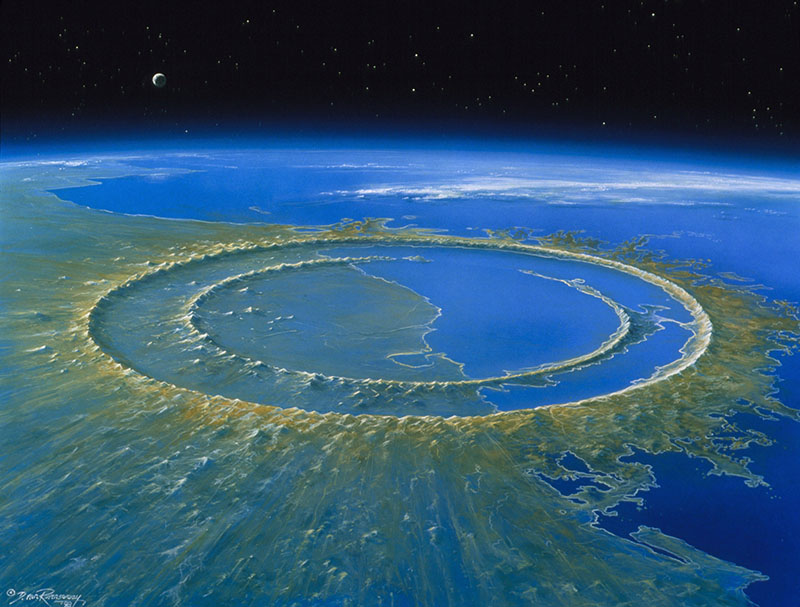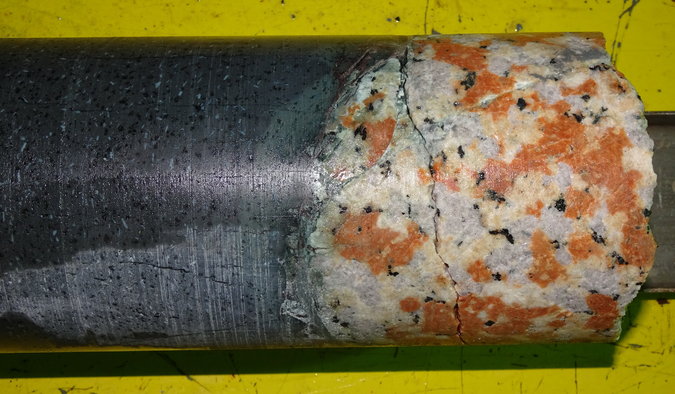Featured Geology & Geophysics Seminar: Dr. Sean Gulick
Mar 28, 2017
Dr. Sean Gulick from the University of Texas at Austin is the featured seminar speaker for the Department of Geology & Geophysics this Friday, March 31 and will be presenting on “Drilling the Chicxulub impact structure: Study of large impact formation” at 11:30 am in Halbouty room 101. Refreshments and coffee will be served.
Dr. Sean Gulick was the co-chief scientist on a team of diverse researchers that drilled offshore into one of the world’s most famous cataclysms – the 66 million year old asteroid impact that led to one of the Earth’s biggest mass extinctions and the demise of the dinosaurs. The impact was so strong, that the asteroid triggered a domino effect of natural disasters, as well as covered the planet with a thick blanket of dust and sediment.
 An artist's recreation of what the Chicxulub crater might have looked like soon after the asteroid struck the Yucatan Peninsula in Mexico.
An artist's recreation of what the Chicxulub crater might have looked like soon after the asteroid struck the Yucatan Peninsula in Mexico.
Researchers studied the peak rings inside the crater. (Photo Credit: Detlev van Ravenswaay/Science Source).
The drilling of the Chicxulub crater began in April of 2016 and is sponsored by the International Ocean Discovery Program (IODP). These scientists targeted the “peak ring” in the crater (a circular ridge inside the crater rim) where they hope to test models of crater formation and determine whether the crater itself was one of the first habitats for microbial life after the impact. According to Dr. Gulick, “Chicxulub is the only crater on Earth with an intact peak ring that we can go sample, the next intact peak ring would be on the moon.” From the core samples, the team has discovered the peak rings are made of shocked granite, which is usually found deeper in the Earth’s crust. The scientists concluded that the asteroid impact was so incredibly powerful, that it lifted sediment from the basement of the Earth’s crust several miles up to its surface.
 Core samples recovered from the Chicxulub crater showing that the peak rings were made of granite. At least half of the core material will be reserved for future study when lab equipment is more advanced than it is today. (Photo Credit: D. Smith/European Consortium for Ocean Research Drilling).
Core samples recovered from the Chicxulub crater showing that the peak rings were made of granite. At least half of the core material will be reserved for future study when lab equipment is more advanced than it is today. (Photo Credit: D. Smith/European Consortium for Ocean Research Drilling).
The rocks the researchers have encountered also include limestones and rocks that contain the fossils from the world after the impact. Some of the ‘disaster species’ that have been identified are organisms that love stressed environments, which include tiny plankton-type organisms like particular forms of dinoflagellates. The team’s results may help end a debate over how the Chicxulub crater formed in the minutes following the colossal collision. Their research can lend support to the dynamic collapse model theory, as well as a challenge for other models.
Dr. Sean Gulick graduated with his Bachelor of Science degree from the University of North Carolina in 1993 and his PhD from Lehigh University in 1999. Gulick is a research professor for the University of Texas Institute for Geophysics, with research interests in marine geology and geophysics, plate boundaries, glacial sequences, and impact processes. His current projects into tectonic and climate interactions in the St. Elias Mountains and Surveyor submarine fan, geohazards and margin evolution of the subduction and transform faulting in Alaska, Sumatra, and Japan, and the geologic processes and environmental effects of the Cretaceous-Paleogene Chicxulub meteor impact.
Dr. Gulick will present his talk this Friday, March 31st at 11:30am in Halbouty room 101 on “Drilling the Chicxulub impact structure: Study of large impact formation.”
The team’s early results were published in the journal Science; the full publication may be found at: http://science.sciencemag.org/content/354/6314/878.full

